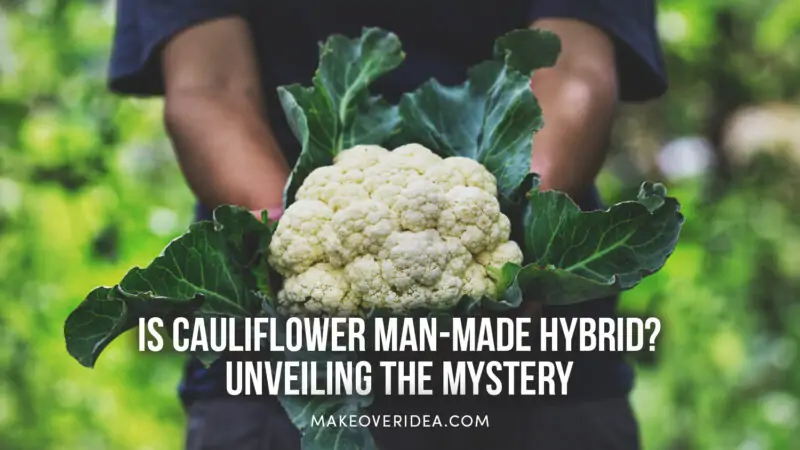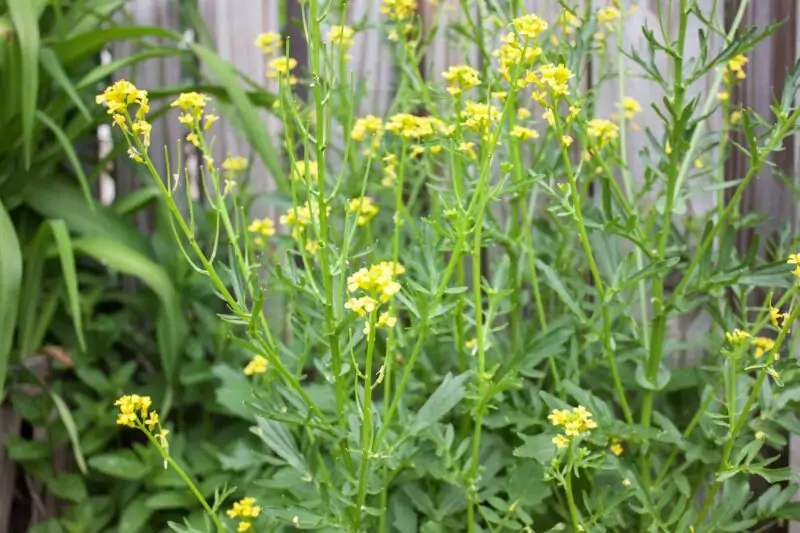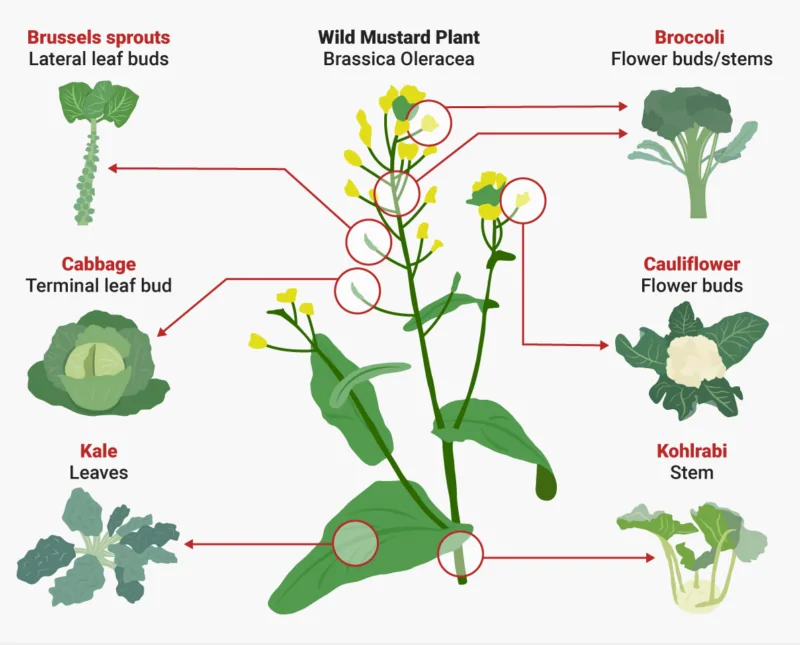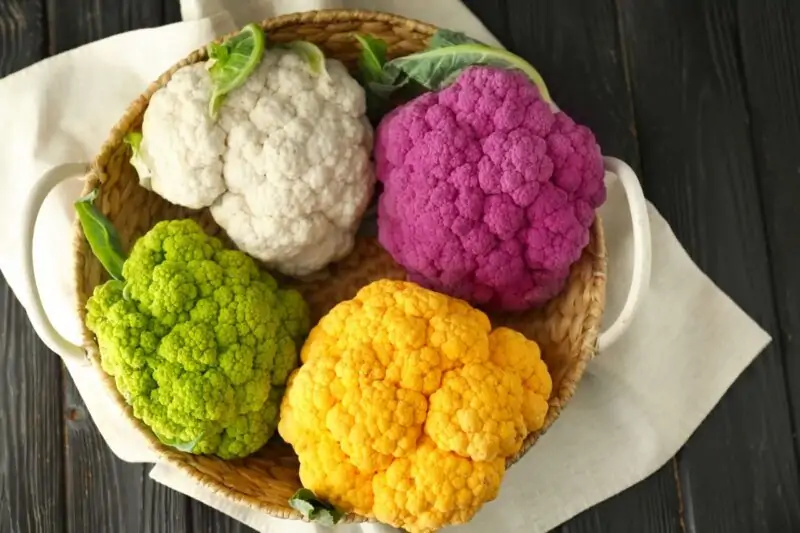Is Cauliflower Man-Made Vegetable? Uncover the Mystery

If you wonder is cauliflower man made or naturally occurring, we have the answers you need. Today we’re going to unveil the mystery and explore everything there is to know about cauliflower and other fruits and vegetables.
The Origins of Cauliflower
What is Cauliflower?
First things first – let’s define what exactly we mean when we say “cauliflower.” It’s a member of the Brassica Oleracea family (which also includes kale, broccoli, cabbage, and Brussels sprouts), with its large flowering head being composed of undeveloped flower buds.
Tracing Cauliflower’s Ancestry
The wild ancestor of all these vegetables was thought to be wild mustard. However, selective breeding over centuries has produced different edible types that today look nothing like their ancestors. And this reimagining isn’t unique only to such visually unusual vegetables as cauliflower and broccoli; it applies also to other brassicas such as kale and brussel sprouts.
So, the short answer to your question is yes, cauliflower is a man-made hybrid.
But wait! There is more to this story. So, before jumping to conclusions about how our beloved cauliflowers are created by humans, let’s dive deeper into the science behind these vegetables!
Man-Made Vegetable or Naturally Occurring?

The Role of Selective Breeding
Selective breeding played a crucial role in producing vegetables with desirable traits. Sizeable flowering heads are only one example of what humans managed to do since they started cultivating plants thousands of years ago.
Modern historians believe that initial cross-breeding was a random event. People merely kept seeds from previous harvests that contained ‘lucky’ mutations towards useful characteristics — like the white colored cauliflower plant, for instance. As time went by, these useful characteristics became fixed for good within selected varieties: this process is called artificial selection and was discussed in detail by Charles Darwin.
These day making of hybrid vegetables is much more refined: modern plant breeders use extensive knowledge from molecular biology. Scientists these days can quickly evaluate which modifications of genomic locations need to be done to achieve the desired result. Rather than waiting for random mutations, many of the vegetables these days are actually man-made foods in the truest sense of this phrase – they are made in a lab.
But we digress – although cauliflower has been around for since ancient times, selective breeding techniques helped the plant receive a ‘modern’ make-over during the 16th century. Still, even though cauliflower has changed significantly over time, it remains a member of its original plant species.
Comparing Cauliflower to Other Brassica Oleracea Vegetables
Now that we know how selective breeding created varieties like cauliflower, let’s compare this process to other vegetables within a similar lineage, such as broccoli or cabbage.
As we have already said, most of these vegetables came from one single ancestor named wild mustard (sometimes called “wild cabbage”) with leaves very much resembling those found in collard greens today.
The Science Behind Cauliflower: is GMO Bad?
Genetic Modification vs Hybridization

As opposed to genetic engineering, which involves forcing genes between entirely unrelated species and splicing them together, hybridization creates new plants by crossing two genetically different yet related parents. Hybridization or breeding parents with special characteristics results in desirable traits – such as color or sizeable flowering heads of the first cauliflower created in prehistoric times – being passed onto hybrids.
It is also important to say that almost all existing plants that we use for food these days and that seem natural are, in fact, created by humans through cross-breeding. While Cauliflower is a man-made vegetable grown for its large flowering head, sweet apples and pears we all love and enjoy are, really, man-made fruits.
On the other hand, genetic modification allows precise changes at specific genomic locations using advanced tools. While hybridization works slowly, genetic modification enables rapid structural modifications – without requiring any physical crossing whatsoever!
Despite being around longer than genetic engineering techniques used nowadays, natural hybridization still underpins many modern cultivars that have only recently appeared on the market, ranging from white carrots up to purple cauliflowers.
Both hybrids and genetically modified forms are commonly (and often misleadingly) referred to as “GMOs”.
Both these practices have their advantages and drawbacks. While GMOs allows scientists to manipulate genes quickly and ensures permanent mutations, sometimes it faces risks of potentially harmful effects that come from unintended interactions between genes. Natural cross-breeding on the other hand might not achieve all target outcomes due to environmental limitations. Still, it is far more predictable in creating edible food.
Cauliflower Varieties and Their Origins
The Colorful World of Cauliflower

Believe it or not – cauliflower comes in various colors! Not that long ago, white cauliflower was the only type we could find in stores. But now you can get types of cauliflower that are colored either purple or white, or green, or orange!
Do you recall seeing purple “Graffiti” cauliflowers? They’re still pretty rare to come by, though if you spot them at your local market some other day, they’ll make for a perfect addition while preparing dishes like quiches and casseroles.
Unique Cauliflower Hybrids
Some interesting ‘man-made’ hybrids include Chinese kale (a cross between broccoli and kohlrabi), broccoflower (which combines broccoli with cauliflower), and romanesco (a delightful mix of all three). All of them look absolutely amazing: you simply can’t take your eyes of the unique shapes, florets swirling around into unusual patterns, and beautiful colors. Each of them is actually a hybrid created not so long ago: little in their appearance reveals the fact that they all come from cabbage.
FAQs
Cauliflower is a vegetable that was made by man, that is, selectively bred over time. It still remains within the original plant genus Brassica.
Through careful selection, growing plants with more generous yields and desirable characteristics, prehistoric men created numerous fruits and vegetables we enjoy today. Cauliflower is just one example of selective breeding.
Yes, both broccoli and cauliflower are considered to be vegetables made by people. They were selectively bred from the same wild ancestor as other brassicas like kale, cabbage, and Brussels sprouts.
As mentioned before, cauliflowers share a common ancestry with other brassica oleracea vegetables such as broccoli, cabbage, kohlrabi (a close relative of turnips), Brussels sprouts (which grow on tall stalks), collard greens (similar to kale but milder in flavor), to name only several vegetables.
Genetically modified organisms or GMOs result from scientists changing genes within an organism’s DNA sequence using state-of-the-art techniques like special enzymes for precise modifications that lead towards desirable characteristics.
Natural hybrids are plants that inherit traits of two different parent plants. Hybrids may have unique combinations of forms and colors that later produce new varieties without any particular human intervention.
Conclusion
Cauliflower is truly an amazing vegetable as it comes in various colors. If is extremely versatile when it comes to cooking up delicious meals. And while selective breeding has played a significant role in shaping what we know today about this plant species, it still remains true that “man-made” doesn’t necessarily mean artificial – after all, these careful breedings took place over thousands of years!
Next time you take a bite out of your favorite color-splashed cauliflower dish – remember how far growers’ patience coupled with taking some risks now and then got us here. It is a truly delightful delicacy – and nutritious too!
So there you have it – the mystery behind is cauliflower man made solved!